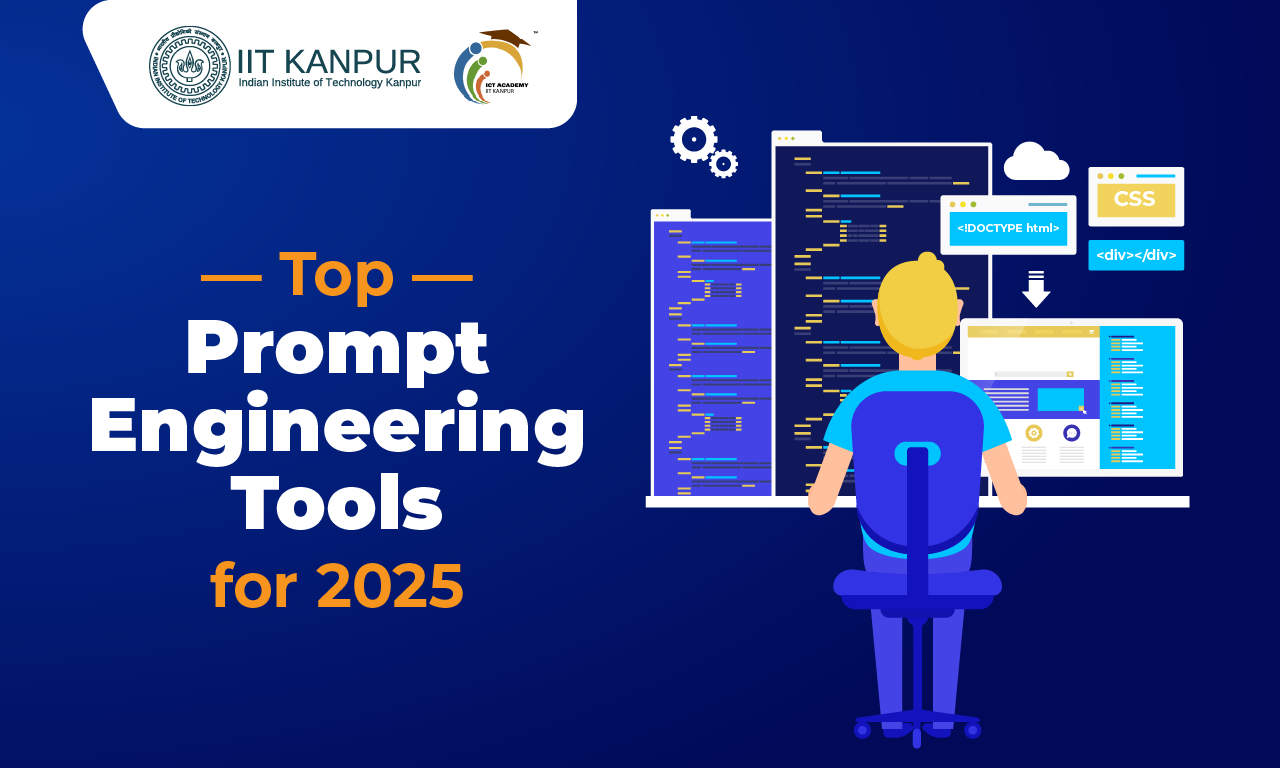The Ultimate List of Top Prompt Engineering Tools in 2025

Prompt Engineering Tools: Prompt engineering is the important process of producing effective prompts that will guide an AI model toward the desired outcome in AI. As the field continues to evolve and develop increasingly complex models, the quality of prompt tools produces the greatest degree of influence on the success of these models if practitioners effectively master techniques in prompt engineering tools, accurate, relevant, and valued results will come from AI models.
In this article, we will cover a complete overview of the top prompt engineering tools in 2025 so that individuals and organizations can begin exploiting these tools to increase efficiency and improve AI application outcomes.
Want to Learn Artificial Intelligence & Machine Learning?
In today’s fast-paced technological landscape, artificial intelligence (AI) and machine learning (ML) have become essential tools for businesses across industries. From automating processes to delivering personalized customer experiences, AI and ML are driving innovation and efficiency at unprecedented levels. As companies increasingly integrate these technologies into their operations, the demand for skilled professionals in AI and ML continues to grow.
Understanding Prompt Engineering
Prompt engineering refers to the art and science of designing effective prompts that guide AI models, notably large language models, to perform as desired. It is the skill that bridges the gap between human intention and machine execution. It calls upon a deep knowledge of the natural language, the subtleties of the architecture and behavior of AI models, and the strategic ability to structure a prompt to get the most relevant and accurate responses. Thus, good engineers need a solid background in linguistics, computer science, and AI to navigate all the complexities of prompt design.
Best Prompt Engineering Tools For 2025
Prompt engineering is the art and science of crafting effective prompts to get desired outputs from AI models. It plays a crucial role in maximizing the possible potential of AI technologies. Here is the list of the best 5 tools for prompt engineering in 2025 to make things easier for you:
1. PromptBase
PromptBase.com is one of the most popular online marketplaces to buy quality AI prompts. It harbours a vast repository of pre-built prompts with this prompt engineering generator. It is a great find for individuals aiming to benefit from AI without extensive expertise in prompt engineering.
Pros:
- Mega-library of prompts: The number of pre-built prompts found at PromptBase is one of the largest sources and endows an individual with unbelievable options across a vast array of domains.
- Facilitates rapid prototyping: Using pre-built prompts, one can rapidly test multiple applications of AI and accelerate the development cycle times.
Cons:
- Dependence on third-party prompts: The quality of prompts provided in PromptBase may vary at times as it is a submission-based approach from the community.
- Cost barrier for premium prompts: Premium prompts may be accessed through an additional charge or subscription, making them less accessible to users.
2. ChatGPT
ChatGPT is an advanced language model developed by OpenAI, which gives it advanced conversational capabilities and makes it generally prompt engineering.
Pros:
- Intuitive and easy to use: The user interface is devised for easy interaction so that it can be accessible to users with every technical background.
- Multilingual support: All these help in supporting a wide range of languages and dialects, thus enabling it to be employed worldwide and communicated among people.
Cons:
- Customization for specialized tasks: While highly versatile, ChatGPT may end up being unsuitable for very special applications unless fine-tuned.
- Dependency on OpenAI’s API: Users rely on the OpenAI API for updates and continuous availability, which may potentially introduce limitations.
3. OpenPrompt
OpenPrompt is one of the valuable tool kits for researchers and developers who want to simplify and optimize prompt engineering for language models. It allows for a user-friendly framework through the process of prompt construction, testing, and deployment across lots of models and tasks.
Pros:
- Rapid prototyping and experimentation: The interface of OpenPrompt is intuitive and modular, making it easy for OpenPrompt to be intuitive and modular, making it easy to develop and experiment with different prompts, speeding up the process.
- Collaborative development and sharing: The open-source nature of OpenPrompt makes OpenPrompt one of the best open source prompt engineering tools. It facilitates the development of a dynamic community where developers share insights, contribute to the toolkit, and learn from each other about the proper methodologies and tools.
Cons:
- Requires technical expertise: Even though OpenPrompt is user-friendly, it is still a tool perceived to have some technical requirements, especially if there is complexity in the use cases you are trying to enforce.
- Integration lag: As new language models are released, sometimes integrating them into OpenPrompt becomes a little delayed.
4. AIPRM
AIPRM is a very friendly Chrome extension that continues to make it easy and intuitive to interact with AI models like ChatGPT. They provide relevant prompts that can be adapted for fine-tuning by the users for better results. This tool is very useful in streamlining how one uses AI in various tasks without necessarily needing technical knowledge.
Pros:
- Enhances Interactions with AI: Efficiency and effectiveness in AI interactions are enhanced with the provision of relevant prompt suggestions.
- Easy to Use: This interface tool is really easy to use, so it can easily be utilized by anyone interested, regardless of his experience with AI. The learning curve is, therefore, small for beginners in AI.
Cons:
- Platform Limitations: AIPRM is only available to be used on platforms that support the use of a browser extension. The compatibility may thus be very limited in some devices or software.
- Limited Customization: Although AIPRM can offer basic-level customization, it may not give the depth of customization desired by an advanced user.
5. OpenAI
OpenAI is a leading platform for accessing and using advanced AI models. It is quite a comprehensive ecosystem for developers and businesses, with an incredibly powerful API that permits access to state-of-the-art models, such as ChatGPT and GPT-4, for designing innovative AI applications.
Pros:
- Versatility: It offers various AI models for completing tasks–from text generation to creating images and developing code.
- Accessible: Its API is user-friendly, and it has a comprehensive amount of documentation, so it is really easy for developers to integrate AI into projects irrespective of the level involved.
Cons:
- Very Expensive: The premium feature and heavy usage are expensive.
- Technical Expertise: Operating with OpenAI often involves a good degree of expertise in AI concepts and programming.
Final Thoughts
Prompt engineering is the next big skill for this fast-changing AI domain. Mastering the art of designing efficient prompts unlocks possibilities in AI models and drives change across industries. The top tools covered in this blog post can be very helpful for beginners as well as for experienced practitioners.
Recommended Courses

Advanced Certificate Program in AI for Leaders

AI & Digital Transformation

AI for Managers

Artificial Intelligence

Deep Learning with Generative AI for Computer Vision

Generative AI

Generative AI Course

Generative AI – 2-Day Offline Workshop

Machine Learning with Python

Professional Certificate Course in Generative AI and Machine Learning

Professional Certificate Program in Leadership with AI



